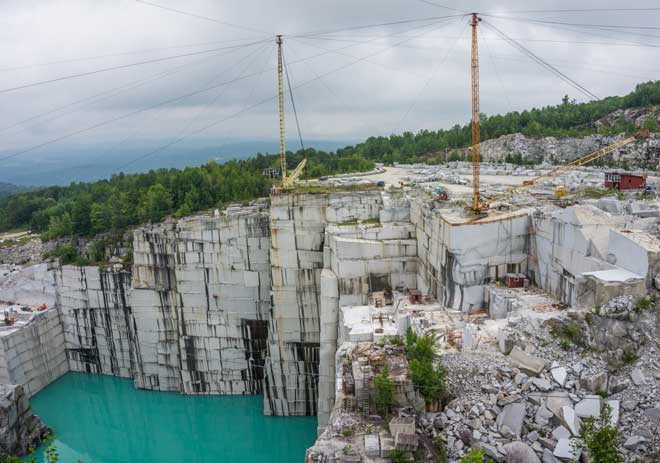Few types of stone offer the same grandeur and character as granite. It may not be the cheapest material around, but with all its color variations and finishes, you can use it for a beautiful traditional, contemporary, or rustic feel.
As a floor covering, granite is exceptionally durable and can last as long as your home does. Here’s everything you need to know about using it for your space.
Pro: Unique Appearance
Granite floor tiles come in a wide variety of styles and colors, including blacks, grays, browns, pinks, blues, and greens. There’s a perfect match for any decor and palette.
Use one color for a traditional look, or combine colors in patterns and random arrangements to liven up your home with something fresh and modern. Even if you stick with a single color, the natural swirls, sparkles, and veins mean your floor will be one of a kind.

You can also choose from a variety of different finishes, including these:
- Polished: Shiny and reflective, perfect for public areas that demand a touch of elegance
- Honed: Matte appearance that reduces glare, perfect for understated areas and rustic environments
- Flamed: Muted colors with a time-worn look, particularly appealing in industrial or aged settings
- Brushed: Slightly textured but smooth overall, offering a nice balance between slip resistance and ease of cleaning
- Antique and brush-hammered: A more pronounced texture for outdoor spaces or areas where grip is a priority
Pro: High Durability
With just a little basic care, a granite floor will last a lifetime. Harder than marble or travertine, granite resists scratches and cracking. It’s an excellent choice for high-traffic areas, even in homes with active kids or large dogs. Because the colors resist fading in sunlight, granite retains its beauty even when used outdoors as patio flooring.
To help your granite floor stand up to wear, moisture, and stains, and to maintain its luster, you might need to apply a sealer periodically. If your floor requires sealing, the ideal schedule depends on the type of floor you have and how much use it gets, although once every four years is the average.
Keep in mind your floor’s color and finish also affect its durability to a certain extent. For example, darker colors show scratches more readily, and honed granite is more prone to staining and etching than polished granite.
Pro: Comfortable and Cooling
Like other stones, granite conducts heat well. When you stand on it, it draws heat away from your feet, providing a nice cooling effect that can spread to the rest of your body. If you’re looking for a more comfortable floor to walk on in hot and humid weather, a refreshing children’s play area, or a cozy floor for pets to sleep on, granite can do the job.
Con: Expensive
Granite floors are some of the most expensive on the market, to the point where even marble costs less. You can find cheaper tiles at home improvement stores, but it’s usually lower-grade stone that lacks the same beauty and durability.
When you’re pricing granite flooring, consider which grade you want:
- Commercial grade: The cheapest granite flooring available, this grade offers only simple, plain coloring with noticeable faults. It’s usually cut quite thin, meaning it requires reinforcement. Some of the very cheapest in this grade are composites of granite and resin.
- Standard grade: This grade has some type of fault and minor irregularities in thickness and cut.
- Premium grade: Flooring tiles of this grade come with uniform thickness and flawlessly cut edges. This is where you’ll find less common colors in more complex, eye-catching patterns.

© vermontalm / Adobe Stock
For the greatest character and durability, look for mid to high-grade granite. According to HomeAdvisor, mid-grade tiles cost about $5 to $15 per square foot, and high-grade tiles cost between $15 and $40 per square foot. You may pay more for specialty tiles with exotic colors or patterns.
Con: Difficult to Install
Installing a granite floor is not a do-it-yourself job if you want optimal results. Each tile is heavy and hard to handle, and it takes skill to lay them the right way. Granite is also hard to cut without the right equipment.
Professional installation is the way to go for these projects. Before laying the tiles, your flooring contractor must make sure the floor is perfectly level. An uneven floor can cause the tiles to crack. Lower-grade granite takes even more work because the uneven edges of the tiles make it difficult to use spacers.
Con: Not Suitable for Every Home
Since granite is so heavy, you need to make sure your home’s structure will accommodate it. A structural engineer can help you verify that your subfloor and home’s overall structure can handle the load.
Polished granite is also quite slippery when wet, so it’s best not to use it for homes where elderly adults or small children live. If you plan to use it in the kitchen or bathroom, you’ll want to put down rugs with rubber backings or non-slip pads to reduce the risk of falls.
In a moderate or cold climate, a granite floor’s cooling effect might not be so comfortable. While you can use it with underfloor radiant heating, it doesn’t conduct heat well enough to be highly efficient, and it’s prone to cracking due to temperature changes.
If you’re looking for professional flooring companies, use the tool below to get estimates from local professionals:








